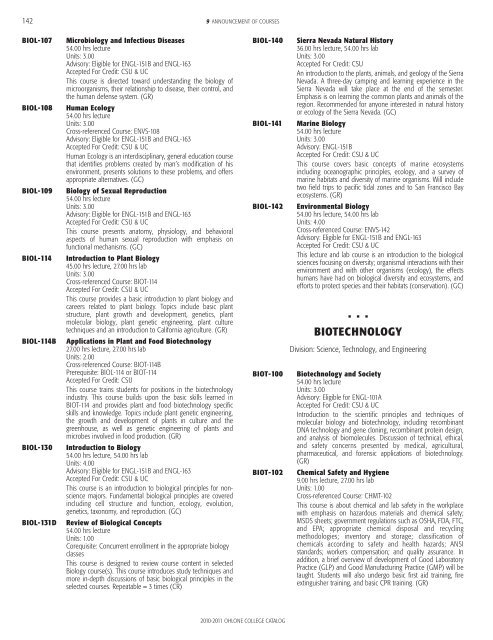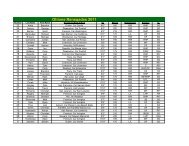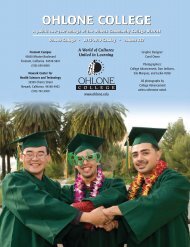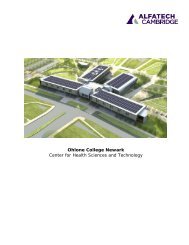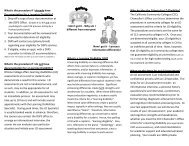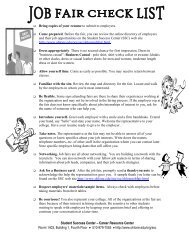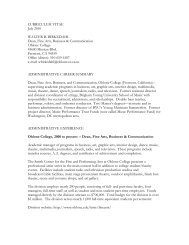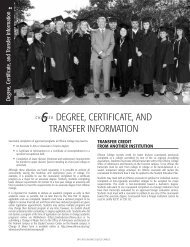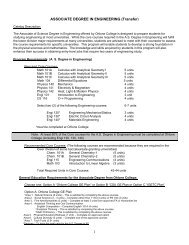2010-2011 Catalog (all pages) - Ohlone College
2010-2011 Catalog (all pages) - Ohlone College
2010-2011 Catalog (all pages) - Ohlone College
Create successful ePaper yourself
Turn your PDF publications into a flip-book with our unique Google optimized e-Paper software.
142 9 ANNOUNCEMENT OF COURSES<br />
BIOL-107<br />
BIOL-108<br />
BIOL-109<br />
BIOL-114<br />
BIOL-114B<br />
BIOL-130<br />
BIOL-131D<br />
Microbiology and Infectious Diseases<br />
54.00 hrs lecture<br />
Units: 3.00<br />
Advisory: Eligible for ENGL-151B and ENGL-163<br />
Accepted For Credit: CSU & UC<br />
This course is directed toward understanding the biology of<br />
microorganisms, their relationship to disease, their control, and<br />
the human defense system. (GR)<br />
Human Ecology<br />
54.00 hrs lecture<br />
Units: 3.00<br />
Cross-referenced Course: ENVS-108<br />
Advisory: Eligible for ENGL-151B and ENGL-163<br />
Accepted For Credit: CSU & UC<br />
Human Ecology is an interdisciplinary, general education course<br />
that identifies problems created by man’s modification of his<br />
environment, presents solutions to these problems, and offers<br />
appropriate alternatives. (GC)<br />
Biology of Sexual Reproduction<br />
54.00 hrs lecture<br />
Units: 3.00<br />
Advisory: Eligible for ENGL-151B and ENGL-163<br />
Accepted For Credit: CSU & UC<br />
This course presents anatomy, physiology, and behavioral<br />
aspects of human sexual reproduction with emphasis on<br />
functional mechanisms. (GC)<br />
Introduction to Plant Biology<br />
45.00 hrs lecture, 27.00 hrs lab<br />
Units: 3.00<br />
Cross-referenced Course: BIOT-114<br />
Accepted For Credit: CSU & UC<br />
This course provides a basic introduction to plant biology and<br />
careers related to plant biology. Topics include basic plant<br />
structure, plant growth and development, genetics, plant<br />
molecular biology, plant genetic engineering, plant culture<br />
techniques and an introduction to California agriculture. (GR)<br />
Applications in Plant and Food Biotechnology<br />
27.00 hrs lecture, 27.00 hrs lab<br />
Units: 2.00<br />
Cross-referenced Course: BIOT-114B<br />
Prerequisite: BIOL-114 or BIOT-114<br />
Accepted For Credit: CSU<br />
This course trains students for positions in the biotechnology<br />
industry. This course builds upon the basic skills learned in<br />
BIOT-114 and provides plant and food biotechnology specific<br />
skills and knowledge. Topics include plant genetic engineering,<br />
the growth and development of plants in culture and the<br />
greenhouse, as well as genetic engineering of plants and<br />
microbes involved in food production. (GR)<br />
Introduction to Biology<br />
54.00 hrs lecture, 54.00 hrs lab<br />
Units: 4.00<br />
Advisory: Eligible for ENGL-151B and ENGL-163<br />
Accepted For Credit: CSU & UC<br />
This course is an introduction to biological principles for nonscience<br />
majors. Fundamental biological principles are covered<br />
including cell structure and function, ecology, evolution,<br />
genetics, taxonomy, and reproduction. (GC)<br />
Review of Biological Concepts<br />
54.00 hrs lecture<br />
Units: 1.00<br />
Corequisite: Concurrent enrollment in the appropriate biology<br />
classes<br />
This course is designed to review course content in selected<br />
Biology course(s). This course introduces study techniques and<br />
more in-depth discussions of basic biological principles in the<br />
selected courses. Repeatable = 3 times (CR)<br />
BIOL-140<br />
BIOL-141<br />
BIOL-142<br />
BIOT-100<br />
BIOT-102<br />
Sierra Nevada Natural History<br />
36.00 hrs lecture, 54.00 hrs lab<br />
Units: 3.00<br />
Accepted For Credit: CSU<br />
An introduction to the plants, animals, and geology of the Sierra<br />
Nevada. A three-day camping and learning experience in the<br />
Sierra Nevada will take place at the end of the semester.<br />
Emphasis is on learning the common plants and animals of the<br />
region. Recommended for anyone interested in natural history<br />
or ecology of the Sierra Nevada. (GC)<br />
Marine Biology<br />
54.00 hrs lecture<br />
Units: 3.00<br />
Advisory: ENGL-151B<br />
Accepted For Credit: CSU & UC<br />
This course covers basic concepts of marine ecosystems<br />
including oceanographic principles, ecology, and a survey of<br />
marine habitats and diversity of marine organisms. Will include<br />
two field trips to pacific tidal zones and to San Francisco Bay<br />
ecosystems. (GR)<br />
Environmental Biology<br />
54.00 hrs lecture, 54.00 hrs lab<br />
Units: 4.00<br />
Cross-referenced Course: ENVS-142<br />
Advisory: Eligible for ENGL-151B and ENGL-163<br />
Accepted For Credit: CSU & UC<br />
This lecture and lab course is an introduction to the biological<br />
sciences focusing on diversity; organismal interactions with their<br />
environment and with other organisms (ecology), the effects<br />
humans have had on biological diversity and ecosystems, and<br />
efforts to protect species and their habitats (conservation). (GC)<br />
n n n<br />
BIOTECHNOLOGY<br />
Division: Science, Technology, and Engineering<br />
Biotechnology and Society<br />
54.00 hrs lecture<br />
Units: 3.00<br />
Advisory: Eligible for ENGL-101A<br />
Accepted For Credit: CSU & UC<br />
Introduction to the scientific principles and techniques of<br />
molecular biology and biotechnology, including recombinant<br />
DNA technology and gene cloning, recombinant protein design,<br />
and analysis of biomolecules. Discussion of technical, ethical,<br />
and safety concerns presented by medical, agricultural,<br />
pharmaceutical, and forensic applications of biotechnology.<br />
(GR)<br />
Chemical Safety and Hygiene<br />
9.00 hrs lecture, 27.00 hrs lab<br />
Units: 1.00<br />
Cross-referenced Course: CHMT-102<br />
This course is about chemical and lab safety in the workplace<br />
with emphasis on hazardous materials and chemical safety;<br />
MSDS sheets; government regulations such as OSHA, FDA, FTC,<br />
and EPA; appropriate chemical disposal and recycling<br />
methodologies; inventory and storage; classification of<br />
chemicals according to safety and health hazards; ANSI<br />
standards; workers compensation; and quality assurance. In<br />
addition, a brief overview of development of Good Laboratory<br />
Practice (GLP) and Good Manufacturing Practice (GMP) will be<br />
taught. Students will also undergo basic first aid training, fire<br />
extinguisher training, and basic CPR training. (GR)<br />
<strong>2010</strong>-<strong>2011</strong> OHLONE COLLEGE CATALOG


